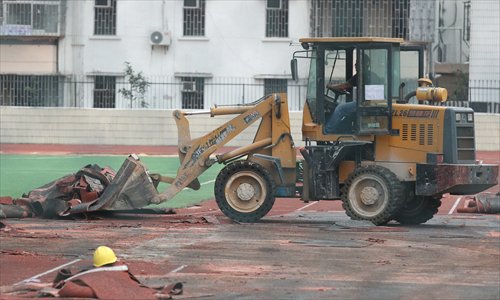Parents fume over toxic tracks
New athletic fields allegedly sicken children across China

An excavator removes a running track at Shenzhen Foreign Languages School in Guangdong Province on Thursday. Tests showed that the track contained the toxic chemical methylbenzene at a level 140 times more than national standards. Photo: CFP
Li Zhiyong's 7-year-old son stays at home after suffering from coughing, bronchitis and conjunctivitis, symptoms which Li believes are caused by the poor quality of a new rubber running track in the boy's school.
"I cannot send my son to school before it removes the track," Li told the Global Times, adding that his son was missing at least two weeks of classes.
About 250 students in the school, Nanshan School Attached to Beijing Normal University in Shenzhen, have developed multiple symptoms including fever, coughing, nosebleeds and rashes since the track was installed over the summer, Li said.
The school posted a notice on November 11 saying that it would tutor children who missed class due to the track.
Education authorities conducted an investigation in late October into 345 playgrounds that have been put into use since 2013.
Eleven schools, including the Nanshan school, were suspected of having problems.
The schools have either entirely removed the tracks, or suspended use of the playground.
The Nanshan School closed down its playground after authorities found "unqualified samples of rubber track," the Shenzhen Education Bureau announced on its website on November 11.
China's Education Ministry has ordered an examination of the quality of school tracks, and ministry official Liao Wenke told media that the use of the suspect tracks must be suspended pending further assessment, the Xinhua News Agency reported on Friday.
Observers believed that the lack of a clear standard for the amount of chemicals in rubber tracks and insufficient supervision were the key reasons for unregulated tracks.
Prevalent track problems
"One could smell the pungent odor of the track even outside the walls of the playground in my son's school," Li told the Global Times.
A group of parents protested outside the school a few days ago, demanding that classes be halted until the track is removed. Currently, the playground is closed.
In another school in Shenzhen, Meilian Primary School, students have been transferred to other schools, Xinhua reported on November 6.
Later the school removed the track and laid down a layer of soil and concrete, according to the Shenzhen Education Bureau.
Schools in Shenzhen are just the latest addition to the list.
Since early October, many students in a dozen of schools in Jiangsu, Zhejiang, Shaanxi, Shanghai and other places have shown symptoms of nosebleeds, rashes and fever, after schools laid down new running tracks during the summer vacation, media reported.
Lax regulation
Wang Zongping, a PE professor at the Nanjing University of Science and Technology, told the Global Times that both the manufacturing and construction process could result in dangerous running tracks.
Rubber running tracks gradually gained popularity in Chinese schools in early 2000s. However, for the past decade, the sales price of tracks did not increase much amid soaring labor costs, Wang said.
"Some track producers used shoddy materials or other dishonest methods," Wang said.
Shenzhen authorities closed down a factory suspected of supplying poor quality cement for running tracks to schools in Futian district, including the Meilian Primary School, the Shenzhen Daily reported on November 9.
China has adopted national standards for the quality of rubber as track material, but no standards for adhesives and additives used in the process of construction, said Shen Weimin, deputy director of the Shanghai Quality Inspection and Supervision Bureau. He said Shanghai has started to make local standards for such materials, Xinhua reported.
Du Sha, a detox campaigner at Greenpeace East Asia, told the Global Times that some construction teams use a toxic plasticizer that could harm children's hormones and trigger reproductive system diseases, and a chemical metal drier that could result in lead poisoning.
"Some Jiangsu schools published test results of their tracks as 'qualified,' even after media reported students suffering from suspected toxic symptoms, because the national standard does not cover additives," Du said.
Improper tests of the tracks also contributed to the toxic track problem, experts said. Schools only focused on slope angle, thickness and smoothness during tests, while ignoring the risk of chemicals, Wang said.
Schools should invite a third party to conduct tests of running tracks, and invite parents' representatives and education authorities to supervise the test, Du said.